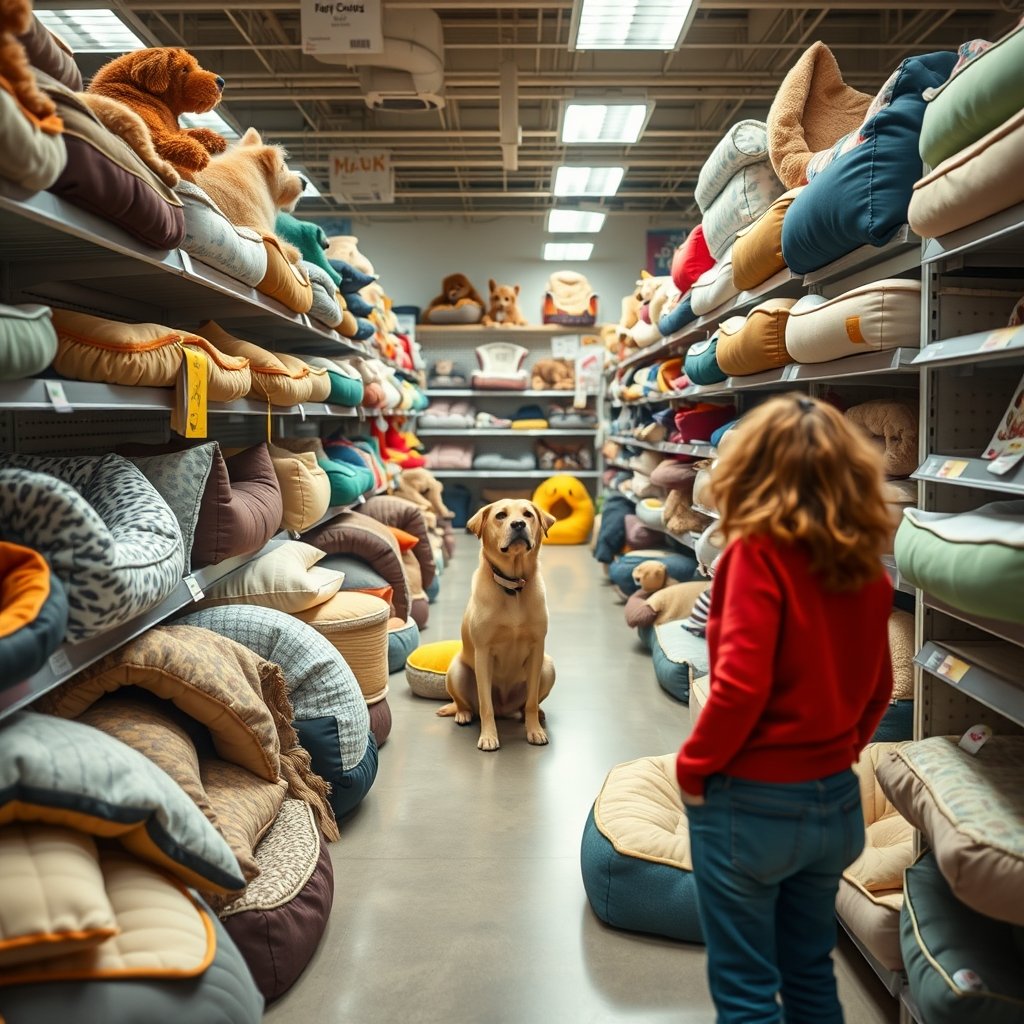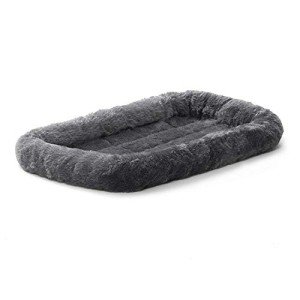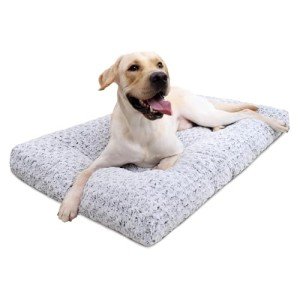How to Choose the Perfect Dog Bed for Your Furry Friend
As a devoted dog owner, ensuring your furry friend is comfortable is a top priority. One of the most significant ways to create a cozy environment for your pet is by choosing the right dog bed. With a myriad of options available, selecting the perfect dog bed can feel overwhelming. This guide provides detailed tips to help you make the best choice for your canine companion.
Consider Size
Choosing the right size bed is crucial for your dog's comfort. A bed that is too small will leave your dog feeling cramped, while a bed that is too large may be challenging for them to navigate.
How to Measure Your Dog
- Measure from Nose to Tail: Use a measuring tape to find the length of your dog from the tip of their nose to the base of their tail.
- Add a Few Inches: To ensure comfort, add a few inches to the measurement. This will give your dog ample space to stretch out and find their ideal sleeping position.
A general rule of thumb is to choose a bed that is at least 2-6 inches longer than your dog's length, depending on their sleeping habits.
Choose the Right Material
Dog beds come in various materials, each with its own benefits.
Types of Bed Materials:
- Foam: Basic foam beds are often more affordable and provide a decent level of comfort. These are great for dogs who enjoy nesting and burrowing.
- Memory Foam: Ideal for older dogs or those with joint problems, memory foam molds to your dog’s body, offering excellent support.
- Orthopedic Foam: A step up from memory foam, orthopedic foam is particularly beneficial for dogs with arthritis or other mobility issues, providing superior support and cushioning.
When selecting a material, think about your dog's specific needs. For example, if your dog suffers from joint pain, investing in a high-quality memory or orthopedic foam bed could significantly improve their quality of life.
Consider Style
Dog beds come in countless shapes, sizes, and designs, allowing you to choose one that matches both your dog’s personality and your home decor.
Tips for Selecting the Right Style:
- Small dogs: Opt for compact beds that don’t overwhelm their size. Cuddler or donut-shaped beds are often a good choice.
- Large dogs: Look for beds that offer plenty of space and cushioning, such as rectangular or bolster-style beds.
Remember that you want the bed to be a comfortable refuge for your dog, so consider their sleeping style (curled up or stretched out) when selecting a design.
Think About Placement
Where you plan to place your dog's bed can influence your choice.
Considerations for Bed Placement:
- Designated Spot: If you have a specific area in mind, measure the space to ensure the bed fits nicely. Choose a bed that complements your decor.
- Portability: If you plan to move the bed around or take it with you while traveling, look for lightweight, portable options that are easy to carry.
Knowing where the bed will reside can help narrow down your choices and ensure it will serve its purpose well.
Consider Your Budget
Dog beds come in a wide range of prices, from basic options under $50 to luxury beds exceeding $500.
Tips for Budgeting:
- Set Your Budget: Determine how much you are willing to spend on a dog bed.
- Research Quality vs. Price: Higher prices often indicate better materials and construction, but not always. Read reviews and look for recommendations to find a bed that offers the best value within your budget.
Investing in a high-quality bed can lead to better sleep and health for your dog, so keep in mind that a higher upfront cost can be worthwhile.
Don’t Forget About Maintenance
Maintenance is a crucial aspect to consider when purchasing a dog bed. A bed that is difficult to clean can become unsanitary quickly, especially if you have an older dog or one with health issues.
Maintenance Considerations:
- Removable Covers: Look for beds with removable covers that can be machine washed for easy cleaning.
- Waterproof Options: For dogs with incontinence issues, waterproof or water-resistant beds can prevent damage and make cleaning hassle-free.
- Hair Resistance: If your dog sheds a lot, find a bed with materials that are resistant to hair buildup, making cleanup easier.
By considering the ease of maintenance, you can ensure that your dog’s sleeping area stays clean and comfortable.
Tips for picking a washable dog bed
Choosing a washable dog bed is a practical decision that helps maintain cleanliness and hygiene in your home. Here are some tips to help you select the best washable dog bed:
1. Look for Removable Covers
- Ease of Washing: Select a bed with a zippered or removable cover, making it easy to take off and wash separately.
- Material Consideration: Ensure the cover is made from durable, machine-washable fabric that can withstand frequent washing.
2. Consider Waterproof Options
- Protecting the Inner Filling: Look for a bed with a waterproof liner or interior to protect against spills, accidents, or moisture. This feature helps maintain the bed’s condition over time.
3. Check the Washing Instructions
- Temperature Settings: Review care instructions to ensure the bed can be washed at appropriate temperatures without damaging the material.
- Drying Options: Confirm whether the cover can be tumble dried or if it should air dry to avoid shrinkage.
4. Choose Stain-Resistant Fabrics
- Fight Odors and Stains: Pick fabrics that are stain-resistant or treated to repel odors, making the bed easier to keep clean and fresh.
5. Assess Durability
- Quality Construction: Select a washable bed with sturdy seams and durable materials to withstand regular washing and your dog’s wear and tear.
- Reinforced Edges: Consider beds with reinforced edges to prevent ripping during cleaning.
6. Opt for Machine Washable Fillings
- Convenience in Maintenance: If possible, choose a bed with fillings that are also machine washable. Some beds allow you to wash the entire bed, adding convenience.
7. Size Matters
- Room for Cleaning: Make sure the bed is not too bulky, as oversized beds can be cumbersome to fit into a washing machine. Check the dimensions before purchasing.
8. Read Customer Reviews
- Real-Life Experiences: Look for feedback from other dog owners about how easy the bed is to clean and how well it holds up after multiple washes.
9. Test for Comfort
- Don’t Sacrifice Comfort: Ensure that even though the bed is washable, it remains comfortable for your dog. Look for styles that provide support and softness.
10. Consider Aesthetics
- Design and Color: While functionality is key, choose a design or color that fits your home decor. A washable bed can be both practical and stylish.
By considering these tips, you can find a washable dog bed that meets your needs while keeping your furry friend comfortable and your home clean.
How to choose an orthopedic dog bed for large breeds
Choosing an orthopedic dog bed for large breeds is essential for their comfort and overall health, especially as they age or if they have joint issues. Here’s a comprehensive guide to help you find the right orthopedic bed for your big dog:
1. Focus on Size
- Measure Your Dog: Measure your dog from nose to tail while they are lying down to determine the appropriate bed size. Larger breeds need enough space to stretch out and change positions comfortably.
- Consider Their Weight: Ensure the bed can support your dog’s weight. Check the manufacturer’s guidelines regarding weight capacity.
2. Look for High-Quality Materials
- Foam Types: Choose beds made from high-density memory foam or orthopedic foam, which provides excellent support and may help alleviate pressure on joints.
- Durability: Ensure that the materials used are durable and can withstand frequent use without flattening or losing shape.
3. Assess the Thickness of the Foam
- Standard Thickness: The foam thickness should ideally be at least 4 to 6 inches for large breeds to provide adequate support.
- Additional Layers: Some orthopedic beds come with multi-layer construction for added comfort and support. Look for beds that have a thick base layer combined with a softer top layer for cushioning.
4. Check for Supportive Features
- Bolsters and Edges: Many orthopedic beds come with bolsters or raised edges, which provide additional neck and head support. This can be beneficial for large breeds that like to rest their heads while sleeping.
- Contoured Designs: Some beds are contoured to fit the shape of your dog’s body, providing extra support for joints and promoting better sleeping positions.
5. Evaluate Cover Materials
- Removable and Washable Covers: Opt for beds with removable and machine-washable covers for easy maintenance. The cover should be made of durable, tear-resistant fabric.
- Water-Resistant Options: Consider water-resistant covers for added protection against accidents, drool, and dirt.
6. Consider Your Dog’s Sleeping Style
- Sleeping Position: Observe how your dog sleeps (curled up, stretched out, etc.) and choose a bed style that complements their preferred position.
- Personal Preference: Some dogs may prefer softer or firmer beds, so if possible, try to determine your dog’s preference.
7. Check for Safety Features
- Non-Slip Bottom: Ensure the bed has a non-slip bottom to prevent it from sliding around, especially on hardwood or tile floors, which can pose a risk for larger breeds.
- Made with Safe Materials: Confirm that the foam and cover are free of harmful chemicals and safe for pets.
8. Research Brands and Reviews
- Reputable Brands: Look for trusted brands known for producing high-quality orthopedic beds. Research customer reviews to gain insights into real-life experiences and satisfaction.
- Warranty/Return Policy: A good warranty or return policy can provide reassurance about the bed’s quality. Look for brands that offer a satisfying policy in case the bed doesn’t meet your expectations.
9. Assess Your Budget
- Balance Quality and Price: While orthopedic beds can be more expensive, investing in a high-quality bed can significantly benefit your dog’s health. Compare features and pricing to get the best value.
- Consider Long-term Investment: A durable orthopedic bed can save you money in the long run by providing better support, reducing the need for additional bedding or potential vet visits.
10. Involve Your Dog in the Decision
- Test Before Buying: If possible, take your dog to a store where they can test the bed themselves. Observe how they react to different types and styles.
By following these guidelines, you can ensure that you select an orthopedic dog bed that provides the necessary support and comfort for your large breed. A well-chosen bed will contribute to your dog’s well-being and enhance their quality of life.
 How to choose a bed for the sprecific breed of your dog
How to choose a bed for the sprecific breed of your dog
Choosing the right bed for your dog depends on their specific breed, as different breeds have unique characteristics, needs, and preferences. Here’s a guide to help you select the perfect bed for various types of dog breeds:
1. Assess Breed Size
-
Small Breeds: (e.g., Chihuahuas, Dachshunds)
- Bed Style: Look for smaller, cozy beds like cuddlers or donut-shaped beds that create a sense of security.
- Considerations: Choose a bed with lower sides for easy access.
-
Medium Breeds: (e.g., Beagles, Cocker Spaniels)
- Bed Style: Beds with a moderate size, such as rectangular or bolster beds, may be ideal.
- Considerations: Ensure enough room for stretching out but still snug enough for comfort.
-
Large Breeds: (e.g., Labrador Retrievers, German Shepherds)
- Bed Style: Look for spacious orthopedic or large flat beds that can support their size.
- Considerations: Ensure they have enough space to stretch out comfortably.

2. Consider Sleeping Habits
-
Curled Up Sleepers: Breeds that tend to curl up when sleeping (e.g., Shih Tzus, Pomeranians) often prefer beds with high sides or circular shapes to feel secure.
-
Stretched Out Sleepers: Breeds that like to sprawl (e.g., Greyhounds, Great Danes) will benefit from flat, spacious beds that allow them to stretch out fully.
3. Support and Comfort
-
Orthopedic Beds for Joint Support: Older dogs or breeds prone to joint issues (e.g., Bulldogs, Rottweilers) should have beds made of memory foam or orthopedic foam to provide extra support.
-
Cooling Beds for Active Breeds: High-energy breeds (e.g., Border Collies, Australian Shepherds) may benefit from cooling beds or those made with breathable materials, especially in warmer climates.
4. Choose the Right Materials
-
Chew-Resistant Fabric for Chewers: If your dog is known for chewing (e.g., Terriers), look for chew-resistant or reinforced materials to withstand wear and tear.
-
Hypoallergenic Materials for Allergies: Breeds with sensitivities (e.g., West Highland White Terriers) should have beds made from hypoallergenic fabrics to minimize irritants.
5. Evaluate Bed Height
-
Low-to-the-Ground Beds for Older Dogs: Breeds that are older or have mobility issues (e.g., Basset Hounds) will appreciate beds that are lower to the ground for easy access.
-
Elevated Beds for Active Breeds: Some active breeds (e.g., Labrador Retrievers) may benefit from raised or elevated beds that keep them cool and provide support.
6. Look for Waterproof or Water-Resistant Options
- For Dogs Prone to Accidents: If your breed is prone to accidents or is very young (e.g., puppies), a waterproof bed or one with a protective liner can help manage messes.
7. Assess Aesthetic and Style
- Compatibility with Home Decor: Choose a bed that complements your home’s decor. Some breeds might prefer stylish options that align with their personality while maintaining functionality.
8. Research Brand Recommendations
- Expert Opinions: Look up specific breed recommendations from veterinarians or pet experts who may advise on the best type of bed for your dog’s breed characteristics.
9. Test for Comfort
- Observe Your Dog: If possible, allow your dog to "test" the bed by seeing how they respond—whether they seem eager to lay down or show a preference for a particular style.
10. Involve Your Dog in the Selection
- Let Them Choose: If you have multiple options, present them to your dog and see which one they gravitate toward. Their preference can guide you in making the right choice.
Conclusion
By considering your dog’s specific breed characteristics, sleeping habits, size, and needs, you can choose a bed that provides comfort and support. A well-selected bed enhances your dog’s quality of life, ensuring they have a cozy and restful place to sleep.
Overall Conclusion
By taking into account size, material, style, placement, budget, and maintenance, you can find the perfect dog bed for your furry friend. A well-chosen bed not only provides comfort but can also contribute to your dog’s overall health and happiness. Your dog will undoubtedly appreciate the thought and effort you put into creating a cozy resting place. With the right bed, your furry companion will have a delightful spot to relax and recharge. Happy hunting!











